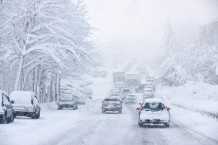Even though it has been a mild winter so far, it is never to late to think about preparing for the winter months.
Make sure your vehicle is ready for that cold, snowy weather.
Here are some great tips from http://www.ready.gov/winter-weather in regards to winterizing your vehicle:
Check or have a mechanic check the following items on your car:
- Antifreeze levels – ensure they are sufficient to avoid freezing.
- Battery and ignition system – should be in top condition and battery terminals should be clean.
- Brakes – check for wear and fluid levels.
- Exhaust system – check for leaks and crimped pipes and repair or replace as necessary. Carbon monoxide is deadly and usually gives no warning.
- Fuel and air filters – replace and keep water out of the system by using additives and maintaining a full tank of gas. A full tank will keep the fuel line from freezing.
- Heater and defroster – ensure they work properly.
- Lights and flashing hazard lights – check for serviceability.
- Oil – check for level and weight. Heavier oils congeal more at low temperatures and do not lubricate as well.
- Thermostat – ensure it works properly.
- Windshield wiper equipment – repair any problems and maintain proper washer fluid level.
- Install good winter tires – Make sure the tires have adequate tread. All-weather radials are usually adequate for most winter conditions. However, some jurisdictions require that to drive on their roads, vehicles must be equipped with chains or snow tires with studs.
Update the emergency kits in your vehicles with:
- a shovel
- windshield scraper and small broom
- flashlight
- battery powered radio
- extra batteries
- water
- snack food
- matches
- extra hats, socks and mittens
- first aid kit with pocket knife
- necessary medications
- blanket(s)
- tow chain or rope
- road salt and sand
- booster cables
- emergency flares
- fluorescent distress flag
And be safe in 2016!











































